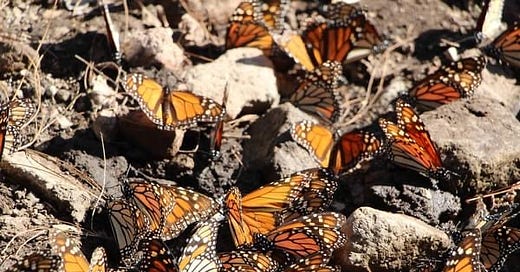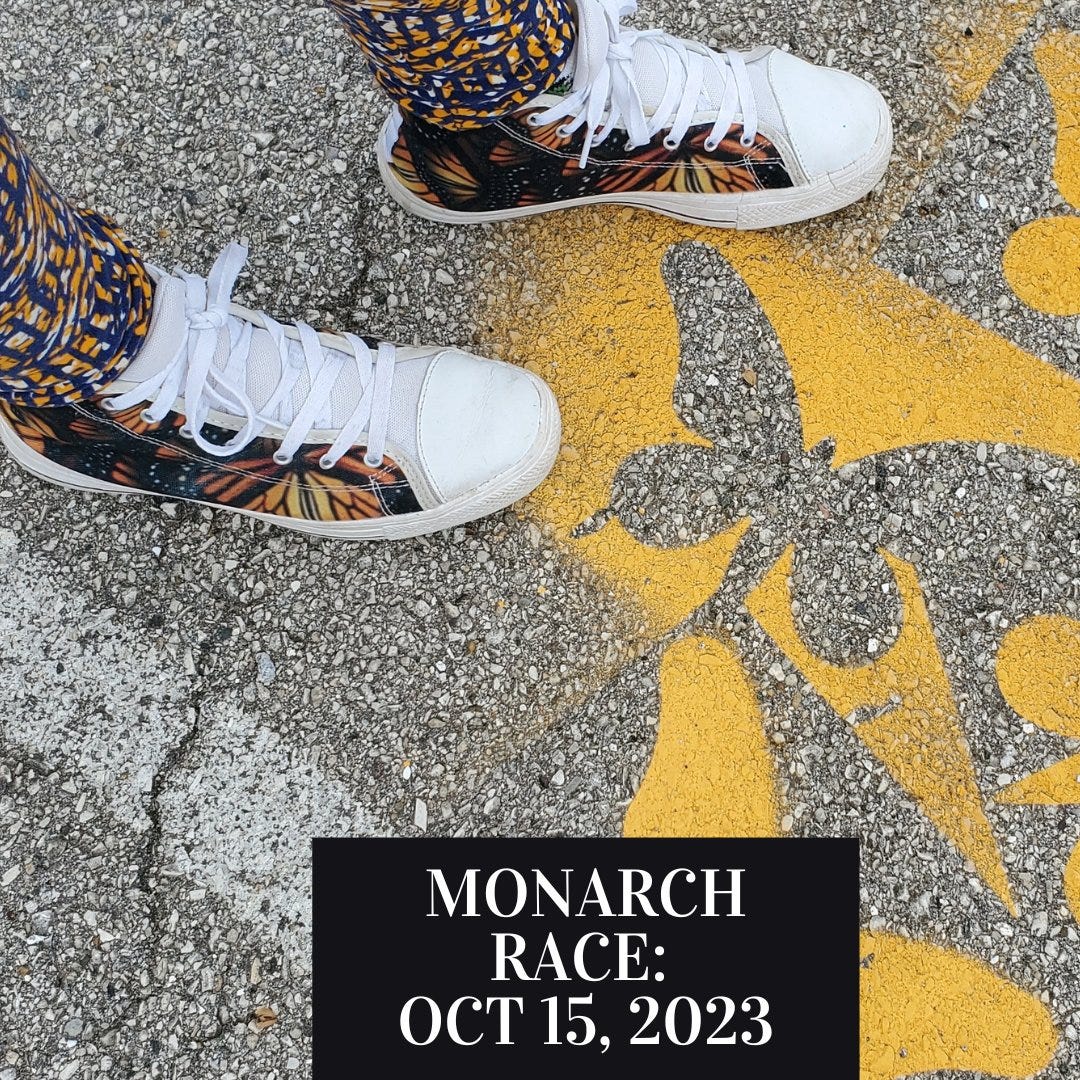Meet the woman using running to protect the world’s ultimate ‘ultra fliers’
When Carlotta James learnt of the threat posed to the Monarch Butterfly, she decided to hold a 4,300km ultra race

John Kelly, Jim Walmsley, Jasmin Paris, Kilian Jornet, Courtney Dauwalter, the Monarch Butterfly.
The discussion over who is the world’s greatest ultra runner could go on and on.
Sorry, did you say the Monarch Butterfly?
Well, the tiny, endangered insect does take a migratory trip of 4,300km (2,670 miles) across three countries - a formidable distance that would make even the best ultra runners question their sanity.
It’s a journey that persuaded a group of runners and environmentalists to create a race to honour the butterfly and raise awareness of its plight: The Monarch Ultra.
The first event took place in 2019, an epic seven week relay from Ontario in Canada to the Sierra Madre Mountains in Mexico, consisting of individual legs of 50km and more.
It has - Covid disruption aside - continued in a variety of forms in the years since, and this year a 10km race is planned for Peterborough, Ontario in October with a 54km ultra between Zitácuaro and the Cerro Pelón Monarch sanctuary in Mexico also in the pipeline.
The aim of the event is to tell the story of the Monarch Butterfly, whose numbers have dwindled significantly in recent years to the point where many campaigners fear they may become extinct.

Project Director and co- founder, Carlotta James, who comes from Peterborough, Ontario, told Running Tales the event came about as a result of her long connection to running, which she has done since she was a little girl, and to environmental causes.
In the summer of 2016, she started noticing there were very few Monarch Butterflies within the natural spaces and trails she was running.
She started to think more and more about what could be done to protect and preserve the butterflies, and as she investigated them Carlotta discovered the incredible distances they migrate.
She said: “I started to think about them as ultra runners or ultra fliers.
“The Monarch Ultra is really a vision for a new way of living with each other.
“I know that sounds a little abstract, but it just means we need to enter a new consciousness, into a new way of living, because of all the challenges that we're facing as a human species.”
Carlotta’s desire to galvanise people to protect the natural environment, coupled with her love of the “beautiful” Monarch, persuaded her to use their migratory journey both as a symbol of resilience and a call to action.
It took three years and “a lot of blood and tears” from her first vision to the start of the Monarch Ultra relay on September 19, 2019.
With the route through Canada, America and into Mexico too long for a conventional race, Carlotta came up with the idea of running it over a number of relay stages with different runners taking on anything from 50k to 100k every day.
“It also meant we could spread the message that much further,” she said.
“Because that one runner is going to have connections and networks and family and friends. And so then they can inspire their networks to do something.
“Whether that means to lobby your government to ban pesticides, to plant pollinator gardens, or to talk to your neighbours.
“Every single moment we have on Earth is a moment to do something positive. And so we just felt doing it as a relay run would make a greater impact.”
The format didn’t come without its challenges though. Because it was such a new event and wasn’t equipped with the usual bling of a medal or the chance to win a race, Carlotta found it hard to fill every available slot.
“Myself and the race director, Clay Williams, who's also an ultra runner, would step in and run 50k on days when we didn’t have anyone else,” she said.
“We ran a lot of legs ourselves. But the thing with anything difficult is the more you do it, it actually becomes easier.
“The first time I did it my body was broken. But then you do it again and again and again.”
Carlotta compares the experience to that of promoting the event, an undertaking which has seen her give speeches to crowds of 200 or more people.
“It's really nerve wracking to talk about something that you're passionate about and to speak from your heart, but then the more you do it, it's like second nature,” she said.
Also on Running Tales:
Start with “stupid” and end in success… What does it take to complete a 145-mile race?
From marathons to best selling books - how running changed Hannah Phillips' life
Taking the Long Path to success: How Kim Levinsky set an FKT on 358-mile route
After the success of the 2019 relay, the Monarch Ultra was - like most events around the world - grounded by Coronavirus in 2020.
The Cerro Pelón Monarch sanctuary, which the event supports, was hit hard by the loss of ecotourism prompting Carlotta and her husband to do a 50km run to raise money for it.
In all, they made $5,000, money that went towards hiring forest protectors to look after the habitat of the butterflies.
In 2021, the event morphed again. With the pandemic meaning the borders into Mexico remained closed, a 2,100km (1,300 mile) relay took place in Ontario over just three weeks.
That event raised $10,000 for Camp Kawartha, an Ontario-based education organisation that teaches kids all about nature.
Last year saw the Monarch Ultra team hold a community event at Peterborough’s Market Hall, followed up by a trip to Zitacuaro for the second international Monarch Butterfly Festival.
Zitacuaro is known as the Monarch Butterfly capital and sits at the gateway to several sanctuaries high up in Mexico’s Sierra Madre mountains.
The plan after that had been to return to the original migratory route relay, but an unexpected twist changed the event format yet again.
Out-of-the-blue, Carlotta was contacted by ultra runner, Anthony Battah, who is currently running the 4,500km from Montreal, Canada to the Monarch Butterfly Biosphere Reserves in Mexico to raise awareness for the butterfly.
His journey will take 90 days, finishing on November 1, but when he first spoke to Carlotta he had just discovered that his grand plan had already been carried out in the form of the Monarch Ultra.
“I was really excited,” Carlotta said. “I gave him our blessing and so he's running 50km every single day until he gets to Mexico.
“We didn't want to have two competing runs to Mexico for Monarchs, so said we’d do something completely different.”
That different is the first ever Monarch Butterfly Festival, due to take place on Sunday, October 15 in Peterborough. It will feature a 10km race, as well as live music, crafts, poetry, dancers, performers, face painting, books, informational booths, and speakers.
The Monarch Ultra organisers are also hoping to hold a second event in Zitacoro on November 26.
Tying in with the International Monarch Butterfly Festival, the plan is to put on a 54km race from Zitácuaro to Cerro Pelón, passing through beautiful rural areas towards the mountains where thousands of Monarchs spend their winter.
Any money raised from the races will go to the sanctuary. It will be used for tree planting in an attempt to counteract years of illegal logging which has blighted the area.
Carlotta said: “I was there last November and it was heartbreaking to see how many trees have been taken down, and in their place avocado farms have started.
“It’s a thing you have to ask yourself if you eat avocados - do you continue to eat them or do you stop eating them?
“But then it also means that Mexican farmers won't have money. The Mexican government, through their economy, needs to provide a different economic system.
“We, of course, don't support cutting down trees in the sanctuary because Monarchs will lose their home. They essentially become refugees.”
While the balance between environmental and economic questions is not always a simple one to achieve, Carlotta has no doubts when it comes to how vital the Monarch is to the ecosystem of the world as a whole.
“Butterflies are part of the group of insects called pollinators. and pollinators are keystone species,” she said.
“Without pollinators everything else on Earth will collapse. We need them for absolutely everything, including food security.
“Most of the food that we eat has been pollinated, including chocolate, coffee and tea, as well as nuts, fruit and vegetables.
“Even the grains that cows eat have been pollinated, so it has ripple effects.
“It’s also about all the flora around the world. Whenever we see a beautiful flower, it needs to be pollinated, including the flowering trees - that also produce fruit.
“That’s why people should care. Scientists have already called it the insect apocalypse. We are in it right now.
“And it's going to be very scary in the future, if our insects continue to disappear.”
Carlotta said her love affair with the Monarch has spread to other pollinators, with nothing making her happier than the sight of bees and butterflies in her garden.
But it’s a happiness tinged with poignancy at the threat faced by the Monarch.
In Canada, there are two migratory populations of the butterfly - and both have seen their numbers fall.
The Western group, which travel from British Columbia to California, only has four per cent of its population left, while the Eastern migratory group - the one followed by the Monarch Ultra from Ontario to Mexico - is also, in Carlotta’s words, on “the road to extinction”.
“There are some groups that don't want to say that,” she added.
“They just would rather say that we need action. But in reality, you always have to look at the numbers.”
‘Now is a critical time for runners to take positive environmental action’
Running Tales: After all is said and run is a reader-supported publication. To receive new posts and support my work, consider becoming a free or paid subscriber. From thinking about our carbon footprint to what we eat and the kit we wear, runners are being urged to put sustainability at the forefront of everything they do.
Carlotta said despite the current grim outlook for pollinators there is plenty people can do to help them, from converting front lawns into pollinator habitat to encouraging schools to have a wildlife area.
One of the most important things to do is learn what plants and insects need in order to survive.
For example, butterflies differ from bumblebees in the way they can pollinate as the latter are generalists able to eat anything. Monarch Butterflies, meanwhile, are specialists which need one plant species - milkweed - to survive.
By not destroying milkweed, often dismissed as a weed, people are helping to ensure the survival of the Monarch.
And after all, the world’s greatest ultra competitor is surely worth saving.
Learn more about the Monarch Ultra and enter the 2023 event by visiting themonarchultra.com
Thanks for reading and listening to Running Tales. We couldn’t do this without your support - please back us to keep going by…








Great story!